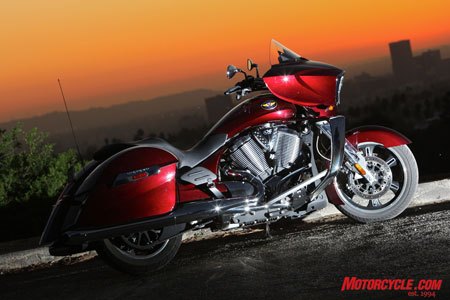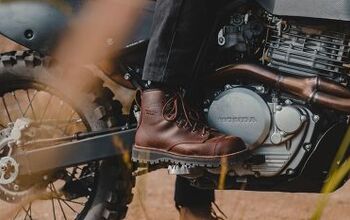2010 Victory Cross Country Review - Motorcycle.com
This past July Victory unveiled two new models: The Cross Roads and Cross Country expand the touring branch to three primary models. (Be sure to read the 2010 Victory Line-up Preview for all the nitty gritty.)
Though we took as thorough a look as possible during the unveiling, our opportunity to start riding some of the 2010 Victorys has finally arrived!
A new member of the Victory family
The Cross Country (and Cross Roads) is a lot of what we already know about Victory, specifically the Vision.
The CC and CR have CORE at their core. That is to say, each of the new models employs technology used in the Vision’s frame to create a new but similar two-piece sand-cast hollow aluminum frame. The Cross bikes do however use the same Freedom 106/6 50-degree V-Twin that powers the luxo-tourer. In our 2009 Luxury Touring comparison the 106/6 pumped out 102 ft-lbs and 85 hp on the dyno.
A tick against the SOHC, air-cooled eight-valve mill is notable buzz – partially the result of a solid-mount engine – detectable mostly through the floorboards around the 3.5-4.5K rpm range in lower gears. However, this annoyance does little to overshadow the powerful thrust the 106 makes.
The CC trades the Vision’s big fairing, trunk bag and sweeping bodywork in favor of a smaller fork-mounted batwing piece.
The traditional fuel tank along with the smaller fairing reduces weight up high resulting in lower overall weight and a lower CoG. This, and a well-balanced chassis, translates into a big bike with excellent low-speed handling. The touring set is always well served by a rig – no matter the make or model – that’s friendly at parking-lot paces.
Housed in the new fairing is an AM-FM tuner with 11 pre-sets and a weather band (WX). An AUX mode enables use of your MP3 player if accessories necessary to use it in the radio are first installed from Victory (or you simply purchased a bike with the radio already set-up). XM radio or CB are also optional elements.
The CC trades the Vision’s big fairing, trunk bag and sweeping bodywork in favor of a smaller fork-mounted batwing piece.
Analog fuel, voltmeter, speedo and tach gauges are augmented by an info-intensive LCD; a panel of warning and indicator lights round out the dash.
The cockpit is smartly laid out with heaps of data easily read at a glance. And the ethereal blue backlighting creates a relaxing atmosphere, like aromatherapy for the eyes. Of course, if you’ve been at the helm of a Vision, then the Country’s dash will look hauntingly familiar, ‘cause it’s the same.
A handy 12-volt cigarette lighter-style power port is tucked conveniently and unobtrusively just under the left speaker. Cruise control buttons located just below the throttle are easy to operate, and are visible at night, too!
A potential drawback with the fairing – depending on rider height – is the amount of buffeting we experienced from around 70-75 mph and up. Depending on conditions, buffeting can be prominent. Below that point the shorty windscreen and fairing do a good job of keeping the rider in a comfortable pocket. We suspect the taller accessory windscreen we’ve seen but not sampled will resolve a lot of this windy business.
The dished-out and low 26.25-inch seat height (0.25-inches lower than Vision) makes for something of an organic ergo package where the rider feels like a part of the bike rather than simply sitting on a seat. Reach to the pullback handlebar is easy; three settings allow fore and aft adjustment of both the shift lever and brake pedal.
Although the stylish 18-inch floorboards (longest in class according to Victory) aren’t adjustable, a small but welcome amount of forgiving upward movement is helpful for those times when you’re draggin’ a board through a turn.
Pretty much what delineates a touring bike from other types of scoots is the inclusion of luggage as standard.
Victory claims a class-leading figure of 21 gallons of carrying capacity in the Cross Country’s (and Roads) hardbag set. They may be the roomiest in-class, but they’re not as voluminous as their large external shape implies. The single pushbutton open/lock combo is easy to operate, and the lids shut with a whoompf, rather than with a slamming plastic-on-plastic note.
A word to the wise: If you don’t specifically lock the bags, then make sure you listen for the barely audible click to ensure the lids are secure. On a couple occasions Good Samaritan motorists feverishly signaled to us a lid had come open.
Four-piston brake calipers bite down on 300mm floating rotors, where on the Vision front calipers are three-piston. The Cross Country’s brake package also differs in that it isn’t linked like on the Vision, and there’s no ABS option. There isn’t quite as much feel at the adjustable brake lever as we’d hoped for, but binders reel in the CC with authority. Rear brake action is plenty powerful and offers decent feel.
Although the Cross Country has marginally milder (0.2-inches more trail) steering geometry than the Vision, an 87 lbs savings in claimed dry weight (765 lbs) enhances the Cross Country’s steering characteristics.
When was the last time a nearly 800-lb tourer begged you to run it in hot and deep into the turn?
The Cross’ neutral handling graces the bagger with remarkably precise steering. The 43mm inverted fork (46mm on the Vision) and air-adjustable mono-shock complement the stout aluminum chassis by providing a comfortable ride, yet overall stability and mid-corner manners are notably a step ahead in this class, begging the rider to explore the bike’s generous lean angle.
V-DNA
Victory designers have always been proud about the boldness of Victory style. And they weren’t fooling themselves when they penned the controversial Vision.
The Cross Country carries many of the lines seen on other models, including the Vision. Yet its style is both modern and classic at the same time, as the purposeful but sweeping lines seem to draw inspiration from the streamline era. The large angular frame protectors that jut out in front of the rider’s knees like small canvas-less sails are an example of Victory’s boundary-pushing styling cues.
"The large angular frame protectors...are an example of Victory’s boundary-pushing styling cues."
The protectors take some getting used to; they certainly, and perhaps purposefully, add visual heft as well as serve the dual role of damage-limiting devices and a place to bolt-in accessory highway pegs.
Giant killer?
Victory made no bones about the Cross Country’s intended targets: Harley-Davidson’s Street/Road Glide and the riders who buy them.
The goal for Victory was to offer as much, and in some respects more of what can be found in the Harleys but for less coin. When Victory unveiled the new tourers in July of this year the Minnesota-based firm stated the Cross Country and Cross Roads would come in under the respective Harley models (Street Glide and Road King) by about $1,000, or $15,999 for the Roads and $17,999 for the Country. California emissions equipment raises MSRP (as it does with many brands) on the Victorys by an additional $250.
It’s a game of tit for tat when attempting to determine a better value, as the Harley at least makes ABS available for $845, while the Vic throws in cruise control, a $295 option on the Glide(s).
According to Victory’s own research, a high percentage of bagger market customers don’t desire ABS or linked braking. But rapidly developing acceptance of high-performance safety-enhancing technology in other market segments tells us bagger people will soon shift paradigms.
So, why not get on board sooner than later?
Even if ABS was made available on the Victory, possibly diminishing price advantages over comparable Harleys it’s still easy for us to see how the Cross Country’s more powerful engine and excellent handling advanced-design frame could steal customers away from the Goliath of American motorcycling.
Related Reading
2010 Victory Line-up Preview
2009 Luxury Touring Shootout
Victory CORE
All Things Victory on Motorcycle.com
More by Pete Brissette


































Comments
Join the conversation